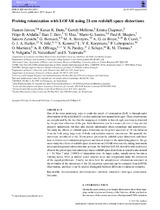| dc.contributor.author | Jensen, Hannes | |
| dc.contributor.author | Datta, Kanan K. | |
| dc.contributor.author | Santos, Mario G. | |
| dc.contributor.author | Mellema, Garrelt | |
| dc.contributor.author | Chapman, Emma | |
| dc.contributor.author | Abdalla, Filipe B. | |
| dc.contributor.author | Iliev, Ilian T. | |
| dc.contributor.author | Mao, Yi | |
| dc.contributor.author | Shapiro, Paul R. | |
| dc.contributor.author | Zaroubi, Saleem | |
| dc.contributor.author | Bernardi, Gianni | |
| dc.contributor.author | Brentjens, M. A. | |
| dc.contributor.author | de Bruyn, A. G. | |
| dc.contributor.author | Ciardi, B. | |
| dc.contributor.author | Harker, G. J. A. | |
| dc.contributor.author | Jelić, V. | |
| dc.contributor.author | Kazemi, S. | |
| dc.contributor.author | Koopmans, L. V. E. | |
| dc.contributor.author | Labropoulos, P. | |
| dc.contributor.author | Martinez, O. | |
| dc.contributor.author | Offringa, A. R. | |
| dc.contributor.author | Pandey, V. N. | |
| dc.contributor.author | Schaye, J. | |
| dc.contributor.author | Thomas, R. M. | |
| dc.contributor.author | Veligatla, V. | |
| dc.contributor.author | Vedantham, H. | |
| dc.contributor.author | Yatawatta, S. | |
| dc.date.accessioned | 2017-07-27T09:17:17Z | |
| dc.date.available | 2017-07-27T09:17:17Z | |
| dc.date.issued | 2013 | |
| dc.identifier.citation | Jensen, H. et al. (2013). Probing reionization with LOFAR (Low Frequency Array) using 21-cm redshift space distortions. Monthly Notices of the Royal Astronomical Society, 435: 460–474 | en_US |
| dc.identifier.issn | 0035-8711 | |
| dc.identifier.uri | http://hdl.handle.net/10566/3114 | |
| dc.description.abstract | One of the most promising ways to study the epoch of reionization (EoR) is through radio
observations of the redshifted 21-cm line emission from neutral hydrogen. These observations
are complicated by the fact that the mapping of redshifts to line-of-sight positions is distorted
by the peculiar velocities of the gas. Such distortions can be a source of error if they are not
properly understood, but they also encode information about cosmology and astrophysics.
We study the effects of redshift space distortions on the power spectrum of 21-cm radiation
from the EoR using large-scale N-body and radiative transfer simulations. We quantify the
anisotropy introduced in the 21-cm power spectrum by redshift space distortions and show
how it evolves as reionization progresses and how it relates to the underlying physics. We go
on to study the effects of redshift space distortions on LOFAR observations, taking instrument
noise and foreground subtraction into account.We find that LOFAR should be able to directly
observe the power spectrum anisotropy due to redshift space distortions at spatial scales around
k ∼ 0.1Mpc−1 after 1000 h of integration time. At larger scales, sample errors become a
limiting factor, while at smaller scales detector noise and foregrounds make the extraction
of the signal problematic. Finally, we show how the astrophysical information contained in
the evolution of the anisotropy of the 21-cm power spectrum can be extracted from LOFAR
observations, and how it can be used to distinguish between different reionization scenarios. | en_US |
| dc.language.iso | en | en_US |
| dc.publisher | Oxford University Press | en_US |
| dc.rights | Copyright the Authors. Authors may archive the published version in their institutional repository. | |
| dc.source.uri | http://dx.doi.org/10.1093/mnras/stt1341 | |
| dc.subject | Instrumentation | en_US |
| dc.subject | Interferometers – methods | en_US |
| dc.subject | Numerical – dark ages | en_US |
| dc.subject | Reionization | en_US |
| dc.subject | First stars | en_US |
| dc.title | Probing reionization with LOFAR (Low Frequency Array) using 21-cm redshift space distortions | en_US |
| dc.type | Article | en_US |
| dc.description.accreditation | Web of Science | |

